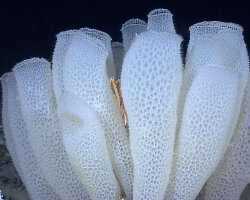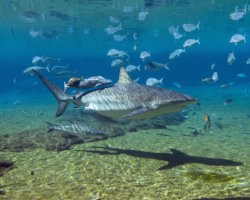Sealife guideGlass sponges: secrets and fascinating life of the deep seaThe marine sponges
Taxonomy
- Phylum: Porifera, sponges
- Class:
- Common name: Glass Sponges, siliceous sponges, or hexactinellid sponges
- Scientific name: Hexactinellida
Description
Glass sponges, also called siliceous sponges or hexactinellid sponges, are characterized by a skeleton made of silica spicules.
These spicules, called hexactines, have six points oriented along three axes. Spicules are divided into two categories based on size: megascleres for large spicules and microscleres for small ones.

The magnificent glass sponge known as the Venus Flower Basket © NOAA under Creative Commons license
Unlike other sponges, the external membrane or ectoderm of glass sponges lacks pinacocytes. Similarly, the internal membrane or endoderm does not have choanocytes but has structures similar to choanocytes without nuclei, forming the choanosyncytium.
Geographic range
Glass sponges live in some of the ocean's most extreme environments, from the dark depths beyond 656 feet (200 meters) to the icy waters of the polar seas, where conditions favor the growth of their siliceous skeleton. Their delicate, glass-like skeletons made of silica allow them to survive where few other creatures can.
Did you know ?
The amazing partnership between glass sponges and shrimp
One of the most fascinating wonders of the ocean is the « shrimp sponge » (Euplectella aspergillum), commonly known as the Venus’ Flower Basket, a type of glass sponge. This sponge often houses a pair of shrimp within its intricate silica framework, whose delicate lattice acts like a natural cage.
The shrimp enter the sponge when they are young and small enough to slip through its openings. Once they grow to adulthood, they become too large to leave, spending their entire lives inside. This arrangement benefits both partners: the shrimp gain a safe haven from predators, while their waste provides nutrients for the sponge.
In Japan, this extraordinary partnership has become a symbol of loyalty and marital devotion, and the shrimp sponge is sometimes given as a wedding gift.
Discover glass sponges

Venus flower basket
(Euplectella aspergillum)
(Euplectella aspergillum)
Our latestUpdates

Friday, December 19th 2025
The magic of Christmas decorations
Discover Christmas decorations in Florida: giant trees, illuminated palm trees, magical light displays and tropical settings to experience the holiday magic under the sun.

Monday, December 15th 2025
The dusky shark
Discover the dusky shark, one of the world's largest coastal sharks, and learn why this powerful predator is essential to marine ecosystems.

Friday, December 12th 2025
Christmas magic at Disney hotels
Experience the magic of Christmas at Disney hotels: enchanting decorations, giant Christmas trees, dazzling lights and a festive holiday atmosphere.
Photo of the Day

Poisson pégase
(Eurypegasus draconis)
(Eurypegasus draconis)
